INTRODUCTION
The ability to cough is an important part of normal lung function. Coughing from time to time helps clear particles and secretions from the lungs and helps to prevent infection. However, sometimes a cough can become a chronic condition that requires a medical evaluation. Chronic cough is usually defined as a cough that lasts for eight weeks or longer. It is a very common problem, and is one of the most common symptom for which patients see a healthcare provider.

CHRONIC COLD AND YOGA
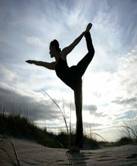
YOGA POSES FOR CHRONIC COLD AND COUGH
Mountain Pose
The Mountain Yoga Pose promotes the experience of stillness, strength, relaxed power, and immovable stability associated with mountains. This yoga posture, and coming back to this stillness after other poses, is one of the ways of becoming acquainted with stillness.
Triangle Pose
In Hindu art, the triangle is a potent symbol for the divine principle, and it is frequently found in the yantras and mandalas used for meditation. The Trikonasana or Triangle Pose concludes the Yoga Postures in our basic session.
Stand Spread Leg Forward Fold
Practicing the Standing Spread Leg Forward Fold can strengthen and stretch your inner and back legs and your spine. People with lower back problems should avoid doing the full forward bend. For beginners, you may use props like a folding chair to support your forearms.
Warrior Pose
The Warrior Pose stretches and strengthens the arms and legs, increases stamina, improve balance and concentration, and can also relieve backaches. If you are suffering from diarrhea, high blood pressure or neck problems, you should take extra caution practicing this pose.
Lotus Yoga Pose
The Lotus Yoga Pose is usually done in Meditation. It is a classic seated posture which strengthens your ankles and knees, enhances concentration, and improves flexibility of your legs. Know how to perform the Lotus Pose in this section.
Boat Posture
Perform the Boat Pose to strengthen your abdominal area and hip flexor, tone muscles in the midsection, improve digestion, and relieve stress. You can use a Yoga Strap to aid you in holding the pose longer or if you cannot keep your legs straight.
Fish Pose
Doing the Fish Pose relieves stiffness of the neck and shoulder muscles and improves flexibility of your spine. It is the counter-pose of the Shoulder stand. Hold the Fish Pose for at least half the amount of time you spent in the Shoulder stand in order to balance the stretch.
Locust Pose
If the Cobra Pose works mainly on the upper back, the Locust Pose targets the lower part. This posture also strengthens the abdominal area, arms, and legs. Another thing that makes it different from many poses is that it entails rapid movement. Check out how it is done in this section.
Bow Pose
The Bow Pose resembles an archer's bow. It strengthens the muscles in the back area, improves posture, and helps in dealing with several gastrointestinal problems. Take note that this Yoga Pose is not for people who are suffering from serious neck or back injury.
Cat Pose
The Cat Yoga Pose teaches you to initiate movement from your center and to coordinate your movement and breath. These are two of the most important themes in Yoga practice. Keep in mind that the Cat Pose may not be advisable if you have any chronic or recent back pain or injury.
Wind Relieving Pose
The term Pavanamuktasana comes from the Sanskrit word 'pavana' which means air or wind and 'mukta' which means freedom or release. The Wind Relieving Pose works mainly on the digestive system. Specifically, it helps in eliminating excess gas in the stomach.
YOGA ASANAS FOR CHRONC COLD
MATSYASANA
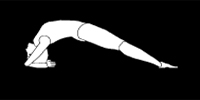
Matsya is a Sanskrit word that means fish so that Matsyasana also referred to as "fish" pose. It is a Hatha yoga pose. It is a counter-pose to Sarvangasana and thus is normally done after Sarvangasana. Unlike other asana that imitate the poses of creatures they’re named after, Fish Pose doesn’t actually look like a fish. Instead, it’s said that if performed this pose in water, the person can float like a fish hence the name Matysasana.
Steps
• Lie straight on your back.
• Now, bend your knees and keep your arms at side.
• Try to arch your back as much as you can while raising it off the ground.
• Push the floor with your elbows.
• At the same time, throw your head backwards.
• Now, rest the crown of your head on the floor.
• Try to support you with your forearms and elbows.
• Expand your chest and take a deep breathe with the abdomen and concentrate on the thyroid gland.
• Hold the position for 1 minute.
• Slowly lose your body and come back to starting position.
SHALABHASANA
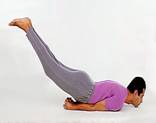
Steps
• Lie on your stomach with legs stretched, and feet together, chin resting on the ground. Keep both your hands under the thighs.
• While inhaling, slowly lift both your legs upwards and stretch as far as possible without bending the knees and toes. Retain this position for some time and then, while exhaling, lower your legs slowly and bring back to the original position.
• Repeat this three to four times.
DHANURASANA
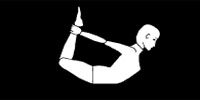
This asana strengthens the abdomen, especially around the navel, and the chest muscles. It improves the flexibility of the arms, shoulders, thighs, legs, lower back and abdomen. The spine also becomes healthy and strong. It is good for relieving flatulence, constipation and menstrual irregularities. It also prevents sterility.
Steps
• Take prone lying position, legs together, hands straight by the side of the thighs, chin resting on the ground. Fold the legs at the knees and bring them on the thighs. Knees must remain together.
• Bring your hands backward and hold the toes of respective legs from the thumb and forefinger of the respective hands.
• Raise your legs a little up and simultaneously raise your head and chest.
• Holding the toes pull the legs towards ears and bring the toes near the ear. Gaze in front.
• While returning to this original position, loosen your hands, take legs backward, let the thighs touch the ground, leave the toes and ultimately bring the legs and hand to the first position
PASCHIMOTTANASANA
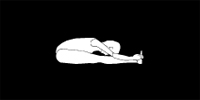
Paschimottanasana, the seated forward bend, is the fifth of the 12 basic postures of hatha yoga. There are many benefits of this posture; the main and most obvious one is to provide a complete stretch of the entire backside of the body from the back of the head through the heels. In one continuous movement, almost all the posterior muscles get fully stretched and relaxed. This helps to improve the functions of the abdominal organs and sets right respiratory disorders. It also helps to improve memory.
Steps
• From Staff Pose - Dandasana bring the arms straight out to the sides and up over your head.
• Inhale and draw the spine up long.
• As you exhale, begin to come forward, hinging at the hips.
• On each inhale, extend the spine, and on each exhale, come a bit farther into the forward bend.
• Keep the neck at the natural extension of the spine.
• Do not round the back.
• Take hold of the ankles or shins, whichever you can reach.
USHTRASANA
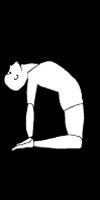
The word "ushtra" refers to "Camel". In this asana, the body resembles the neck of a camel, that's why it is called 'Ushtrasana'.This asana expands the lungs to their maximum capacity and develops the ribcage. The elasticity of the diaphragm also improves.
Steps
• Sit with legs stretched, heels together, palms pressing on the ground by the side of buttocks, to keep the body at right angles to the legs with an erect spine.
• Bend right leg backwards.
• Bend the left leg to come to Vajrasana.
• Raise up making the trunk vertical.
• Inhale and bend the body backwards and bring the hands on the heels.
ASTROLOGY
Yoga is the primary level which consists of bodily exercises to build a ground for Meditation. The word yoga had been derived from the Sanskrit word yuj which means to join to unite to balance or to integrate. Yoga is a system of exercises for the mental and physical well being. It combines stylized poses with deep meditation and breathing. According to Patanjali, within the human body there are channels called Nadi and centers called chakra. If these channels & canters are tapped, energy hidden in the body can be released. This energy is called kundalini. In the broadest sense Yoga thus means integration at three levels Body, Mind and soul. According to astrological reports for yoga asanas the above mentioned asanas are said to be effective for those who come under the following zodiac sign
• PISCES